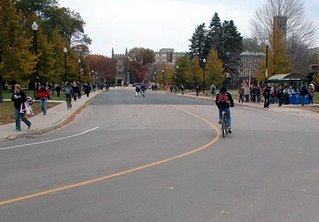
McMaster University each year repairs our roads and sidewalks to provide a safe environment for our University community. This program is managed by our Physical Plant through a plan and budget prepared by Parking Services.
You may recall the poor condition that University Ave was, particularly in the area of the bus stops. In some spots the road bed was exposed through the asphalt making it quite unsafe.
The plan for University Avenue rehabilitation called for road bed reconstruction and patching. Unfortunately when opening the road for repairs the contractors found areas where a partial concrete roadbed existed. This concrete base was collecting water and had led to the premature aging of the existing road. Without its removal any repair conducted would have led to the same premature aging and cracking. Therefore the project's scope of work was adjusted and the concrete slabs removed and weeping tile drainage added.
This project has a good appreciation of the future plans and McMaster's desire to make the area sensitive to pedestrians and bicycle riders. The work that was just completed in rebuilding the road will mean that next year's project to continue the pedestrian focused campus plan will not have to do this basic work before proceeding, resulting in a significant dollar savings.
As well, awaiting the next phase of the University Ave project to begin, our Parking Services will be doing the following
* painting a wide island down the middle of the road from Sterling to College Crescent
* painting a highly visible crosswalk in the mid point of University that lines up with the primary crossing from Engineering to MDCL
* construction of a permanent island (plants etc., in middle) on Scholars Lane for a distance of about 100 metres. ONLY emergency vehicles and service vehicles providing services to buildings in Scholars Lane will be granted access.
These are some of the projects that we have been undertaking to ensure the safety of our McMaster Community and our mission to contribute to pedestrian safety in the University Core.
You might wish to contact Terry Sullivan, at Security and Parking for any additional information. (23372)
Yours sincerely,
Peter George